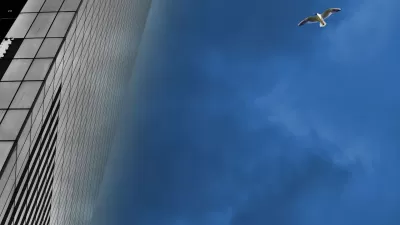A lethal combination of a rapidly expanding modern skyline and the intersection of several major migratory flight paths have rendered Toronto one of the world’s most deadly cities for migratory birds, reports Ian Austen.
Modern architecture's infatuation with glass has been a lethal development for birds across the world. In North America alone an estimated 100 million to one billion birds are killed every year in collisions with buildings. In Toronto, a combination of factors make that city one of the world's deadliest.
"So many birds hit the glass towers of Canada's most populous city that
volunteers scour the ground of the financial district for them in the
predawn darkness each morning," writes Austen. "The group behind the bird patrol, the Fatal Light Awareness Program,
known as FLAP, estimates that one million to nine million birds die
every year from impact with buildings in the Toronto area."
Thanks to the persistence of FLAP, the city has recognized the extent of the problem and is taking measures to help address it. FLAP is now using the courts to push developers and building owners to do their share. "After years of conducting rescue and recovery missions and prodding the city to include bird safety in its design code for new buildings,
FLAP has recently begun using the courts to help keep birds alive. It
is participating in two legal cases using laws normally meant to protect
migratory birds from hunting and industrial hazards to prosecute the
owners of two particularly problematic buildings."
FULL STORY: Casualties of Toronto’s Urban Skies

Alabama: Trump Terminates Settlements for Black Communities Harmed By Raw Sewage
Trump deemed the landmark civil rights agreement “illegal DEI and environmental justice policy.”

Planetizen Federal Action Tracker
A weekly monitor of how Trump’s orders and actions are impacting planners and planning in America.

The 120 Year Old Tiny Home Villages That Sheltered San Francisco’s Earthquake Refugees
More than a century ago, San Francisco mobilized to house thousands of residents displaced by the 1906 earthquake. Could their strategy offer a model for the present?

Ken Jennings Launches Transit Web Series
The Jeopardy champ wants you to ride public transit.

BLM To Rescind Public Lands Rule
The change will downgrade conservation, once again putting federal land at risk for mining and other extractive uses.

Indy Neighborhood Group Builds Temporary Multi-Use Path
Community members, aided in part by funding from the city, repurposed a vehicle lane to create a protected bike and pedestrian path for the summer season.
Urban Design for Planners 1: Software Tools
This six-course series explores essential urban design concepts using open source software and equips planners with the tools they need to participate fully in the urban design process.
Planning for Universal Design
Learn the tools for implementing Universal Design in planning regulations.
Clanton & Associates, Inc.
Jessamine County Fiscal Court
Institute for Housing and Urban Development Studies (IHS)
City of Grandview
Harvard GSD Executive Education
Toledo-Lucas County Plan Commissions
Salt Lake City
NYU Wagner Graduate School of Public Service




























